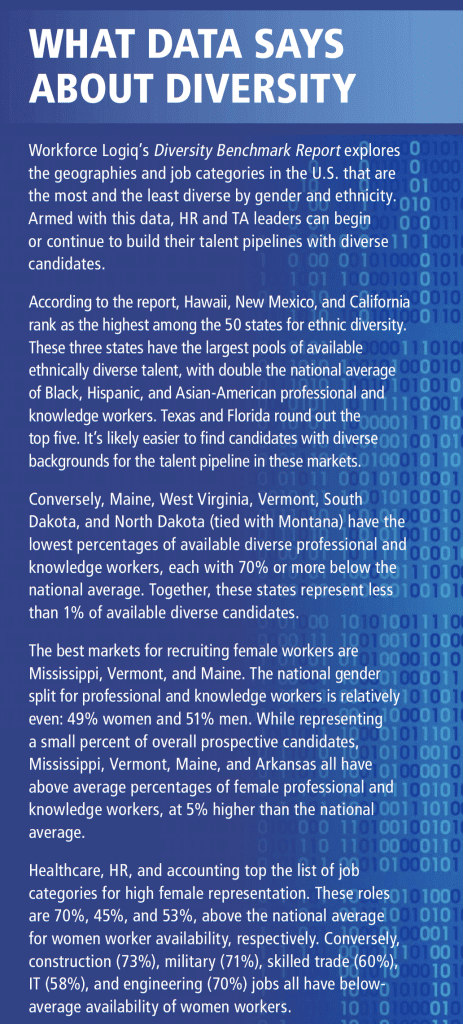Four best practices to consider when implementing more inclusive hiring practices.
By Dr. Christy Petrosso and William T. Rolack, Sr.
Organizations looking to quickly boost employee representation can use predictive data to understand which markets have the largest number of available diverse candidates for specific roles, and focus pipelining efforts in those areas. This hyper-targeted approach delivers a bigger return on diversity hiring investments, especially when working with limited resources, which is the case for many companies today given the ongoing economic uncertainty.
There are four things every HR and TA leader should consider when building out their D&I strategies.
1. Boosting gender diversity doesn’t always mean hiring more women. In some cases, such as in the nursing field, increasing employee representation may mean hiring more men. And while a job category may look diverse overall, closer examination of specific roles or levels could tell a different story. Within the airlines industry, for example, pilots are heavily skewed toward men (95% male versus 5% female). Flight crews, on the other hand, are predominantly female, which would mean targeting male attendants. Gender-based diversity programs would require identifying the underrepresented gender earlier on in the recruiting process.
2. The best overall market from which to source a particular role might not be the best for diversity. Sales development representatives are one of the most in-demand remote jobs right now. The best market to look at when sourcing these candidates based on salary profiles and market-specific talent supply and demand gaps is the Denver, CO area. However, the top market for hiring diverse candidates for the same role would require employers to shift their focus to San Jose, CA. This metro area has the largest pool of available diverse candidates for sales development representatives.
3. D&I progress looks different for every company and industry. With predictive diversity data and metrics, organizations can proactively compare their own performance with national, industry, and peer group benchmarks. This insight enables hiring and recruiting leaders to understand what success looks like and where they need to boost worker representation to raise performance. The restaurant industry, for example, performs well for overall ethnic diversity, with its total percentage of Black, Hispanic, and Asian-American professional and knowledge workers 20% higher than the national average for all industries. However, the Asian- American benchmark is underperforming at 48% below the national score. The industry’s gender diversity is also an area of concern, at 7% below the national average for woman professional and knowledge workers. Employers in this sector should focus on building their recruiting pipeline with more Asian-American and women prospects.
 4. Current approaches to D&I are manual, time consuming, and less effective. Traditional diversity pipeline strategies like referrals, relationship building, community outreach, and internal training of recruiting staff are valuable methods, but often result in inconsistent D&I outcomes. And broad, consistent access to diversity metrics and competitive data that organizations can use to further their D&I progress has generally been lacking. Advances in AI and predictive intelligence are easing these burdens by helping employers predict which candidates are most likely to have diverse backgrounds, enabling organizations to quickly identify and include prospective hires with the right skill sets and from underrepresented communities in the front end of the recruiting funnel.
4. Current approaches to D&I are manual, time consuming, and less effective. Traditional diversity pipeline strategies like referrals, relationship building, community outreach, and internal training of recruiting staff are valuable methods, but often result in inconsistent D&I outcomes. And broad, consistent access to diversity metrics and competitive data that organizations can use to further their D&I progress has generally been lacking. Advances in AI and predictive intelligence are easing these burdens by helping employers predict which candidates are most likely to have diverse backgrounds, enabling organizations to quickly identify and include prospective hires with the right skill sets and from underrepresented communities in the front end of the recruiting funnel.
When exposed to new cultures, ideas, and perspectives, employees learn from each other and grow, enhancing an organization’s ability to innovate, perform, and adapt more easily to shifting market and consumer demands. McKinsey reports companies that embrace gender diversity within their executive teams are 21% more likely to experience above-average profi tability. Organizations with ethnic and cultural diversity have a 33% likelihood of out performance on EBITA margin over non-inclusive organizations.
But to reap these rewards, employers need to be armed with context and data, so they know where and how to invest in talent diversity to meet the specific needs and goals of their organization. The organizations that replace assumptions with data-based decision making and link D&I initiatives with larger business objectives are the ones that will create and sustain real and lasting inclusivity within the workforce.
Dr. Christy Petrosso is chief data scientist and talent economist and William T. Rolack, Sr. is vice president of diversity and inclusion for Workforce Logiq.














